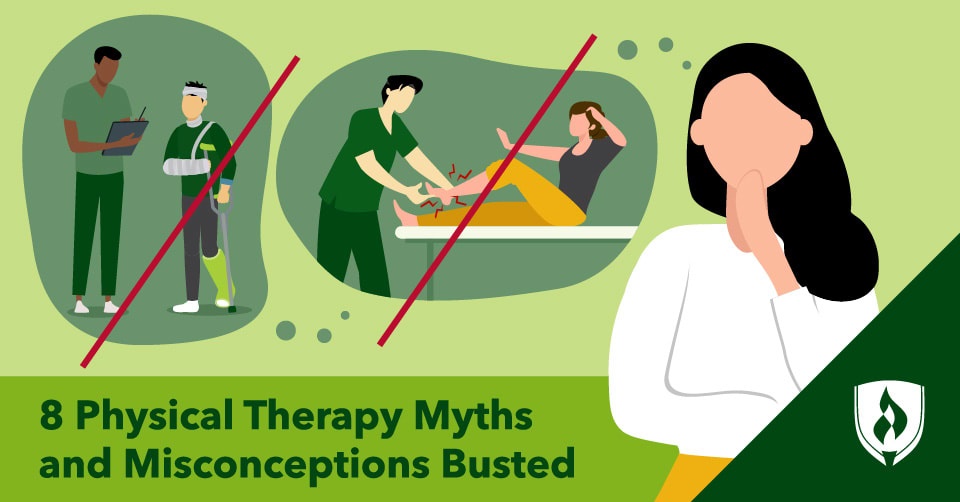
Have you ever heard that physical therapy is only for injuries? That it will be rather painful? While some things you’ve heard about physical therapy may have a sliver of truth to them, there are a lot of physical therapy misconceptions that can prevent people from exploring it as an avenue to healing or as a viable career path.
Ranging from mild misunderstandings to outright hindrances to patient health, these physical therapy–related myths and misconceptions are frustratingly persistent. It’s time to correct the record—so keep reading to learn what the world of physical therapy is really like.
8 Common physical therapy myths and misconceptions
1. Physical therapy is only for treating acute injuries
Many people actually get help from a physical therapist because of day-to-day problems that aren’t born out of a dramatic injury or accident. For example, if you clench your jaw with stress, a physical therapist can offer exercises to help ward off jaw problems. Or if repetitive movements at work are causing wrist problems, a physical therapist can suggest strategies to avoid carpal tunnel syndrome down the road.
In this way, physical therapists can help prevent serious injury. Preventative exercises and stretches that a physical therapist can recommend are less invasive than having to get surgery when that annoying problem turns to injury.
Jake Dickson, certified personal trainer and contributing editor BarBend®, says, “Physical therapy can assist with a variety of ailments, such as pain management and musculoskeletal disorders, as well as more specific conditions, such as chronic headaches, lower back pain, carpal tunnel syndrome and frozen shoulder.”
2. Insurance doesn’t cover physical therapy
The first question out of most people’s mouths when hearing about something medical is “Will my insurance cover that?” It’s a legitimate concern for many people with the expensive cost of medical care, but the automatic assumption is often that physical therapy won’t be covered by insurance. However, every insurance plan and patient circumstance is different, and jumping to this assumption isn’t necessarily accurate.
Many insurance companies cover different types of physical therapy as it can be the financially prudent option.
“Physical therapy has been shown to minimize other health care expenditures by reducing the need for prescription medicines, surgery and imaging,” says Dickson. “Physical therapy can also assist patients in preventing conditions from becoming permanent and avoiding falls, so it’s reducing costs in these ways.”
Even if a particular insurance plan doesn’t cover physical therapy, in the long run, it may be worth the cost now to avoid greater cost (and physical pain) later.
3. Physical therapy is painful
Speaking of physical pain, many imagine that physical therapy will be quite painful. Stretching after a workout can be pretty uncomfortable, so physical therapy is probably at least that level of pain, right?
“Although you may have minimal pain or discomfort at the beginning of your treatment, I believe the primary objective of physical therapy is to reduce pain and discomfort,” says Dickson. “A competent physical therapist will operate within your pain threshold to restore function and mobility while facilitating healing.”
Dickson explains that anything greater than mild pain should be mentioned to your physical therapist, and they may be able to tweak the care plan accordingly.
Meredith Castin, physical therapist at the Non-Clinical PT®, explains that this myth stems from some of the more uncomfortable physical therapy types, like helping patients achieve full motion after knee surgery amidst swelling and inflexibility. “We physical therapy professionals have been called ‘physical terrorists’ or ‘physical torturers’ over the years, and that’s because some post-op rehab can be painful.”
4. Physical therapy will work within only a few sessions
While anybody in pain or not feeling one-hundred percent hopes for quick relief, sometimes, there are no shortcuts to recovery. Physical therapy can provide some immediate relief in certain cases. However, full recovery may not come even after several sessions.
Dr. Stephanie Carter Kelley, a physical therapist, explains that it’s a myth that physical therapy will be finished within “the six to eight sessions of PT provided by your insurance.” She says that “Healing from pain, especially persistent, recurring or chronic pain, takes time. PT gives you a great start, but that’s just it…a start.”
Recovery can be a long road, but it can also be worth it.
5. You always need a referral to go to physical therapy
There are plenty of cases where you might need a referral from your primary care doctor, especially if you’re not sure which specialist you should see. But if you know that pulled shoulder muscle really needs a physical therapist, then there’s likely no need to waste time waiting for a referral.
“You can refer yourself to PT in almost every state,” says Kelley. You can simply call in and make yourself an appointment to find out how physical therapy could help you heal.
That said, it’s worth checking in with your insurance provider and confirming first to avoid potential billing complications.
6. Only your primary care doctor can determine if you need physical therapy
For some people, asking a doctor for a physical therapy referral may have resulted in the doctor recommending another treatment route. However, getting the opinion of an actual physical therapist on whether they can help is a more reliable route.
Kelley notes that physicians often won’t recommend exercise or physical therapy for musculoskeletal issues and that some healthcare systems will have patients get an MRI or X-ray before referring the patient to a physical therapist.
7. Physical therapy is only for athletes
“Many people assume that a physical therapist or physical therapist assistant only works with athletes,” says Castin.
While montages of hulking football players rehabilitating torn ligaments are often a common first exposure for some to the concept of physical therapy, athletes are just a small portion of their patient base. In reality, physical therapists treat everything from people with a pulled muscle from jogging to a repetitive stress injury caused by an office job.
Castin explains that physical therapists work at locations from schools to nursing homes. “You’ll even find PTs working in care coordination and case management roles,” she says.
8. Physical therapists are basically personal trainers
Along with the athletic myths, it’s easy for those who aren’t familiar with the field to think that physical therapists are the same as personal trainers. After all, a good personal trainer can give you advice for injuries or soreness—and you may even see PTs working in the same location. However, the two are separate jobs with vast differences in the training and education required.
“Yes, some physical therapists are also personal trainers,” says Castin, “but the two fields are very different. Physical therapists are required to obtain doctorates to enter the field, and they are professionally licensed and required to pass a rigorous national competence examination in order to practice.”
On the other hand, she explains that there is no similar requirement for personal trainers. Therefore, most personal trainers won’t have the same medical expertise, training and experience that physical therapists do.
Physical therapy as a career path
Whether you’re not an athlete or you don’t have a referral, you can still see a physical therapist. Physical therapists can help with everything from muscle soreness to surgery recovery. And with their specialized medical training and experience, they offer non-invasive solutions that many general practitioners are unfamiliar with.
With all the different ways that physical therapists can help a variety of patients, they are an integral part of the medical system and recovery process. Despite the physical therapy myths, physical therapists provide important medical care. And now that you know what’s not true about physical therapists, find out about all the different careers within the physical therapy field with our article “Careers in Physical Therapy: Exploring Your Options.”
BarBend is a registered trademark of Barbend, Inc.
The Non-Clinical PT is a registered trademark of The Non-Clinical PT, Inc.




